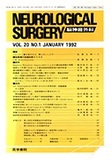Japanese
English
- 有料閲覧
- Abstract 文献概要
- 1ページ目 Look Inside
I.はじめに
Gliobiastoma multiforme(以下GM)は予後不良な腫瘍であるが7),脊髄GMは特に予後不良と思われ,3年生存例をほとんど認めない2-6,8,10,12,13,15).われわれは脊髄円錐部に原発した本症に対し亜全摘術(初回手術),放射線療法(65Gy),化学療法,lymphokine-activated kil—ler(以下LAK)細胞髄腔内注入療法,脊髄切断術(再発時手術)を施行し,3年6ヵ月をこえて生存している症例を経験したので,若干の文献的考察を加えて報告する.
A 35-year-old woman was admitted to our hospital with a 3 month history of progressive paraparesis and impairment of bowel and bladder function. MRI sug-gested a malignant glioma at the level of T9 to LI. Laminectomy and subtotal removal of the tumor was performed. The surgical specimen was a glioblastomamultiforme. An aggressive adjuvant therapy was sche-duled to prevent rapid local regrowth and leptomenin-geal dissemination. Radiotherapy with a total dose of 65Gy was delivered with chemotherapy including ACNU (2mg/kg) and vincristine (0.2mg/kg). Lympho-kine-activated killer (LAK) cells were given intrathe-cally with a total dose of 1.6×109 LAK cells with 3×104 units of IL-2. MRI taken 6 months after surgery re-vealed no residual tumor, and no malignant cell was de-tected in the patient's CSF. After physiotherapy, she became able to walk with a stick and was discharged. Chemotherapy (ACNU 2mg/kg/8 weeks) had been further continued for 2 years. She did well until 14 months after surgery, when paraparesis recurred and rapidly progressed to completism. MRI revealed a spin-al cord swelling with marked edema, suggesting de-layed radiation necrosis. Two years after surgery, MRI showed a marked atrophy of the spinal cord, and no re-sidual tumor. But 3 years after surgery, a round tumor at the level of T11 and T12, was revealed on MRI, and she was admitted to our hospital again. A spinal cord amputation was performed, and the tumor was totally removed without worsening her neurological symp-toms. Surgical specimen of the tumor was glioblastoma multiforme again. Thirty-nine months after the first surgery she has been living at home as a house wife. The prognosis of spinal cord glioblastoma is quite fear-ful. The rapid postoperative regrowth and the high fre-quency of leptomeningeal dissemination appear to be responsible. The authors pointed out that to suppress the former a local high-dose irradiation is recom-mended, and to prevent the latter an intrathecal infu-sion of LAK cells may be effective.

Copyright © 1992, Igaku-Shoin Ltd. All rights reserved.


